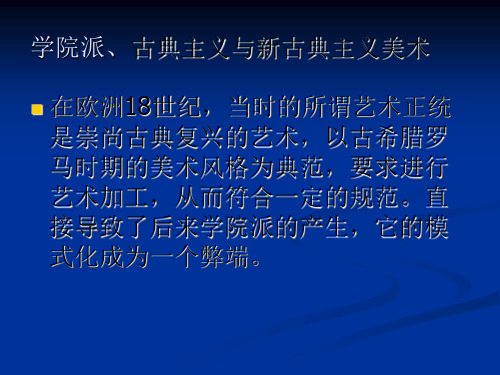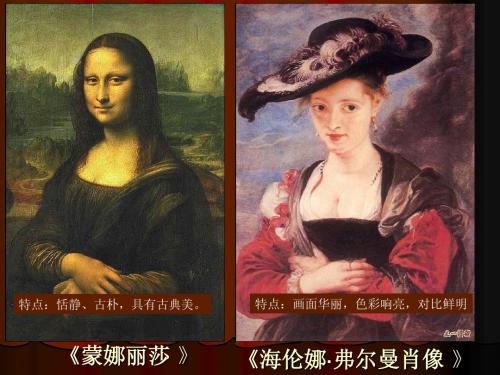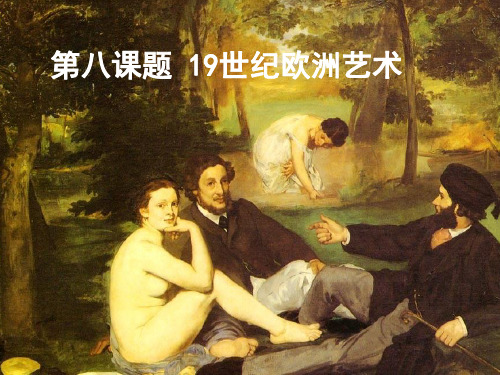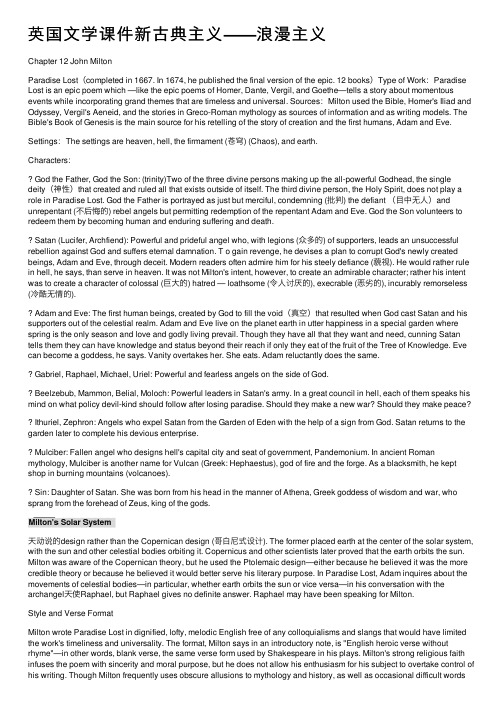新古典主义、浪漫主义 ppt
英国文学.ppt

The Renaissance Period marks a transition from the medieval to the modern world .It refers to the period between the 14th and mid-17th centuries. It first started in Italy ,with the flowering of painting , sculpture and literature. From Italy the movement went to embrace the rest of Europe . The Renaissance which means rebirth or revival ,is actually a movement stimulated by a series of historical events ,such as the rediscovery of ancient Roman and Greek culture ,the new discoveries in geography and astrology(占星学),the religious reformation and the economic expansion .
literature
⒈Old and Medieval English Literature (约 5C后期—1485) ⒉The Renaissance Period (15C后期--17C初) ⒊ The Neoclassical Period (17C中期—18C中 期) ⒋ The Romantic Period (1798—1832) ⒌ The Victorian Period (1836—1901) ⒍The Modern Period (1918—1945 ) ⒎ The Contemporary Period (1945– now)
新古典主义 ppt课件

Know then thyself, presume not God to scan 认清自己,莫妄想探讨神
The proper study of Mankind is Man. 该人类研究的对象就只有人。
(the great chain of being)
The great chain of being 生存的巨链
⑥Renaissances and Neo-classicism
Limitless potentials Individualism
Confessional writing Enthusiasm Lyrics
Man as limited Member of the
society Social observation Order, rules Satire
His lines are smooth, Balanced and concise, many of them have become household saying:
A little learning is a dangerous thing. 一知半解是最危险的事。
Drink deep or taste not the Pierian Spring . 要深透允饮,不然就尝不到知识源泉的甘霖
the expansion 4.intellectual movement : Enlightenment
an intellectual movement esp in 18th century when people believed reason and science not religion would advance human progress.
Hills peep o’er hills, and Alps on Alps arise! 山外有山,学无止境。
新古典主义、浪漫主义

新古典主义与浪漫主义的融合:在现代艺术中,新古典主义和浪漫主义经常相互融合,共同创 造出独特的艺术风格和表现形式。
价值与影响:新古典主义与浪漫主义在现代艺术中的运用,不仅丰富了艺术表现形式,还对现 代社会的审美观念和价值观念产生了深远的影响。
03
浪漫主义的定义和 特点
浪漫主义的起源和发展
浪漫主义的起源 可以追溯到18世 纪末的欧洲,是 对启蒙运动的一 种反叛。
浪漫主义强调情 感、个性和自然, 与新古典主义的 理性、秩序和规 范形成鲜明对比。
浪漫主义文学、 音乐和艺术都表 现出对个人情感 和自由的追求, 以及对传统束缚 的反抗。
浪漫主义在19世 纪初达到高潮, 并对后世文化和 艺术产生了深远 的影响。
促进跨文化交流:新古典主义与浪漫主义在不同文化背景下的传播,有助于现代艺术在不同 文化间的交流与融合。
新古典主义与浪漫主义的艺术价值和文化意义
新古典主义:强调秩序、平衡和规范,对现代设计、建筑和雕塑产生深远影响。
浪漫主义:追求个性、情感和自然,对现代文学、音乐和绘画产生重要影响。
新古典主义与浪漫主义的艺术价值:丰富了世界艺术宝库,为现代艺术发展奠定基础。 新古典主义与浪漫主义的文化意义:反映了特定历史时期的社会思潮和文化氛围,对 现代人理解历史和人类文化有重要意义。
浪漫主义的艺术特点
强调个人情感和个性表达 追求自由、无限和永恒 强调自然美和人与自然的和谐 重视想象力和创造力的发挥
浪漫主义在各个艺术领域的影响
文学:强调个人情感和想象力, 反对束缚和限制
音乐:注重情感表达和旋律, 创造了许多经典作品
古典主义、新古典主义、浪漫主义与折中主义

• 法国新古典主义——罗马复兴“帝国风格” 巴黎雄狮凯旋门 • 英国新古典主义 大英博物馆——希腊复兴 国会大厦——哥特复兴 • 德国新古典主义——希腊、哥特复兴 新天鹅城堡 • 俄国——罗马复兴 海军部大厦 • 美国 华盛顿国会大厦
• 折中主义——流行于19世纪后半叶,巴黎 美术学院是其老巢。 • 折中主义——集仿主义 • 巴黎歌剧院,法国折中主义纪念碑。 艺术特点:立面设计和室内装饰 巴黎圣心教堂
古典主义、新古典主义、浪漫 古典主义、新古典主义、 主义与折中主义
• 古典主义产生于法国,流行于尼德兰和英 国。 • 古典主义:弥漫着一种堂堂大度的贵胄气 派,强调基于严格数学计算的比例和数量 关系的精确性。
卢浮宫改造后的东立面
Hale Waihona Puke 古典主义园林——凡尔赛宫花园
拉东娜水池
• 巴黎著名的古典主义建筑 荣军院教堂 万神庙 • 英国最大的教堂是伦敦圣保罗教堂 • 俄国的叶卡捷林娜宫 圣彼得堡东宫
最新室内设计(新古典主义风格)ppt课件

1.1 全过程的管理
全面质量管理要求对产品生产过程进行全面控制。
5.2基本观点
• 以预防为主的观点 • 以预防为主,就是对产品质量进行事前控制,把事故消灭在发生之前,使
于控制状态。 • 用数据说话的观点 • 科学的质量管理,必须依据正确的数据资料进行加工、分析和处理找出规
技术和实际情况,对存在问题作出正确判断并采取正确措施。
10.概念
•质量的定义 国家标准(GB/T19000-2008 / ISO9000:2005)对质量 一组固有特性满足要求的程度。更流行、更通俗的定义 角度去定义质量:质量是用户对一个产品(包括相关的 程度的度量。
•质量的主体,主要包括: (1)产品和/或服务的质量; (2)工作的质量; (3)设计质量和制造质量。而后两者往往容易被人们 这是“大质量”管理思想和管理方法所必不可少的。
卫浴间这样私密的空间,即使不秀 给别人看,也要自己用的舒服。现 在的卫生间装修设计讲究的不仅仅 是实用,更多的在于一种心情的享 受。来看看这款新古典的卫生间吧, 或许它所带来的那股自然的暖意能 够在这寒冷的冬天打动你。这样淡 淡地温暖系是不是很打动人心了。 暖色调的瓷砖铺贴,恰到好处的室 外光线的投射,让小房间的卫浴间 变得暖意十足。其整个色调和空间 的设计灵感考虑的都很周到,虽然 空间小,但是温度系数高,这样温 暖自然风的房子最能打动人心。一 点绿植的点缀可谓点睛之笔。
3.管理工具
全面质量管理的常用七种工具 •1.统计分析表法和措施计划表法 •质量管理讲究科学性,一切凭数据说话。因此对生产过程中的原始质量数据的统计分析十分重要,为此必 工作特点设计出相应的表格。 •2.排列图法 •排列图法是找出影响产品质量主要因素的一种有效方法。 •3.因果分析图法 •因果分析图又叫特性要因图。按其形状,有人又叫它为树枝图或鱼刺图。它是寻找质量问题产生原因的一 •4.分层法 •分层法又叫分类法,是分析影响质量(或其他问题)原因的方法。我们知道,如果把很多性质不同的原因搅 来的。其办法是把收集来的数据按照不同的目的加以分类,把性质相同,在同一生产条件下收集的数据归 映的事实更明显、更突出,便于找出问题,对症下药。 •5.直方图法 •直方图(Histogram)是频数直方图的简称。它是用一系列宽度相等、高度不等的长方形表示数据的图。长方 间隔,长方形的高度表示在给定间隔内的数据数。 •6.控制图法 •控制图法是以控制图的形式,判断和预报生产过程中质量状况是否发生波动的一种常用的质量控制统计方 程中的过程质量动态,具有稳定生产,保证质量、积极预防的作用。 •7.散布图法 •散布图法,是指通过分析研究两种因素的数据之间的关系,来控制影响产品质量的相关因素的一种有效方
外国美术史PPT学院派,古典主义,新古典主义

大卫《马拉之死》
安格尔简介 (1780-1867) 1780-1867) 法国古典主义画派最后的代表:安格尔 让一多米尼克·安格 让一多米尼克· 尔,生于蒙特庞省。·他曾经向杜尔兹学习绘画17岁时到巴黎,投 尔,生于蒙特庞省。·他曾经向杜尔兹学习绘画17岁时到巴黎,投 入达维特门下。当时,达维特正担任拿破仑的首席画师。安格尔 极受达维特的喜爱,达维特曾为他画过一幅肖像:那微微皱起的 眉毛下,有着一双认真思考的眼睛。1806年,安格尔赴意大利, 眉毛下,有着一双认真思考的眼睛。1806年,安格尔赴意大利, 1824年回到巴黎。后来,1834—1841年,他再度赴罗马,深刻地 1824年回到巴黎。后来,1834—1841年,他再度赴罗马,深刻地 研究了文艺复兴时期意大利古典大师们的作品,尤其推祟拉斐尔。 经过达维特和意大利古典传统的教育,安格尔对古典法则的理解 更为深刻,· 更为深刻,·产达维特流亡比利时之后,他便成为法国新古典主义 的旗手,与浪漫主义相苏衡。 作为19世纪新古典主义的代表,安格尔并不是生硬地照搬古代大 作为19世纪新古典主义的代表,安格尔并不是生硬地照搬古代大 师的样式,他善于把握古典艺术的造型美,把这种古典美融化在 自然之中。他从古典美中得到一种简炼而单纯的风格,始终以温 克尔曼的“静穆的伟大,崇高的单纯” 克尔曼的“静穆的伟大,崇高的单纯”作为自己的原则。在具体 技巧上,“务求线条干净和造型平整” 文社里语,见《 技巧上,“务求线条干净和造型平整” (文社里语,见《西欧近 代画家》一书) 代画家》一书)。因而差不多每一幅画都力求做到构图严谨、色彩 单纯、形象典雅,这些特点尤其突出地体现在他的一系列表现人 体美的绘画作品中,如《 体美的绘画作品中,如《泉》、 《大宫女》、 《瓦平松的浴 大宫女》 女))、 《土耳其洛室》等 。 ))、 土耳其洛室》
新古典主义 ppt课件

His lines are smooth, Balanced and concise, many of them have become household saying:
Neo-classicism
(The Age of Reason)
18th century
Ⅰgeneral introduction Ⅱ Neo-classicism Ⅲ representatives
1.the moderate school 2.the radical school 3. Sentimentalism 4.pre-Romanticism
Ⅱ Neo-classicism
1.definition:a movement from the Restoration till the end of 18th century, which emphasizes on order, reason( not emotion), restraint, common sense, and conservatism (not imagination). The representatives modeled after Greek and Latin authors.
人教版第五课,巴洛克、浪漫主义、古典主义美术课件

吕德《马赛曲》
凯旋门右侧门柱的浮 雕也被命名为马赛曲。 其中象征自由、正义、 胜利的自由女神右手持 剑,左手高举,号召人 民向她指引的方向前进。 在她神圣宽广的羽翼下, 一群志愿军战士,或高 歌猛进,或负重前行, 马赛曲的雄壮号角再次 响起,映衬着香榭丽舍 大道每一天的朝阳万丈 和落日余辉。
《吉普赛女郎》
画家使用细腻多情的笔触, 描绘了少女的面孔和胸部, 而以流动的小笔触描绘富 有动感的秀发,又用饱含 激情奔放的大笔触表现衣 裙,形成笔触语言的对比 与和谐。画面色彩以暖色 排列形成热情豪放美感。 红色的裙子和发辫上的红 色发带上下呼应,使整个 画面充溢着永恒的生命气 息和乐观自尊自信的精神 气质。
伦勃朗《夜巡》
《弹曼陀铃的小丑》 哈尔斯
画家选择了一位处于社会 底层的流浪艺人,着意描 绘他那乐观诙谐的小丑形 象。他的装束和表情虽然 显得滑稽可笑,却显示了 荷兰平民的性格特征:他 们幽默机智,忍辱负重, 对艰涩的人生怀着乐观的 态度,画家抓住了他那转 瞬即逝的眼神,透露出他 那幽默机灵、充满欢乐的 内心世界。巧妙的笔触神 奇地表现在画布上,给人 以活灵活现的感情交流。
《阿波罗与达芙妮》
从这组作品中,优美流动的 曲线变化和纤细的柔美风格上, 可以看出贝尼尼对纯正古典美的 深刻理解和掌握,这是他对希腊 古典雕刻艺术的继承和发展。组 雕《阿波罗和达芙妮》的成功, 轰动了整个罗马,一个晚上全罗 马人都知道继米开朗基罗之后意 大利又出一个大雕刻家贝尼尼。 一位大主教看了这组雕像激动地 说:这是一个诱人的达芙妮。另 一位主教还写了一首诗:迷恋的 人儿追赶着欢乐,这昙花一现的 美色啊!他得到的只是一个苦果, 几片绿叶.
是德拉克罗瓦最具有浪漫主义色彩的作品之一。画家 以奔放的热情歌颂了这次工人、小资产阶级和知识分 子参加的革命运动。高举三色旗的象征自由神的妇女 形象在这里突出地体现了浪漫主义特征。她健康、有 力、坚决、美丽而朴素,正领导着工人、知识分子的 革命队伍奋勇前进。强烈的光影所形成的戏剧性效果, 与丰富而炽烈的色彩和充满着动力的构图形成了一种 强烈、紧张、激昂的气氛,使得这幅画具有生动活跃 的激动人心的力量。
新古典主义、浪漫主义

又一位杰出的色彩大师。
德拉克洛瓦的首件力作是1822年的《但丁小舟》 1824年德拉克洛瓦又创作了《希阿岛的屠杀》,被认为是向古典派的 一次挑战,标志着浪漫主义盛期的到来。 德拉克洛瓦的代表作是创作于1830年的《自由引导人民》,此作品被 当作浪漫主义的典型代表作。
希阿岛屠杀
(德拉克洛瓦) 《希阿岛的屠杀》 取材于19世纪30年代, 希腊人民反抗土耳其 统治而进行的一场举 世瞩目的事件,表现 希腊民族所遭受的凌 辱。 这件作品从内容到 形式大胆地破坏了古 典绘画的传统,把全 部注意力放在色彩与 构图的力度上,使用 豪放的大笔触,通过 明暗对比与人物的姿 态,古 典主义美的追求, 高贵、雅致,甚至 一种不凡的气质透 溢其间,《贝尔坦 肖像》最能体现这 种美学品格。贝尔 坦是一位精力充沛 的法国报界人士。 《贝尔坦肖像》
安格尔
安格尔的名画《泉》令多少人 为之陶醉,奥秘在于画家抓住了 人体内部力的微妙关系:少女向 左倾斜的双肩和向右倾斜的胯部, 向上超拔的用力和向下倾倒的水 罐,前曲的右膝和后绷的左腿, 都体现了力的打破平衡和恢复平 衡;尤其是少女全裸的胴体,显 示着坦然开放的态度,而她紧紧 夹住的大腿和紧抓水罐的双手, 又暗示着内心的羞涩和拘谨,更 给人以妙不可言的力的对抗。它 在观众感觉上引起相应的紧张度 和轻松感,在一张一弛之间体验 着生命的活力。
新古典主义产生的原因有两方面: 一、以农业为基础的重商主义的君主政体。 二、考古发现与科学研究的推动。
一、新古典主义美术产生的背景
18世纪下半叶,法国资产阶级和封建贵族 之间的矛盾日益尖锐,一场巨大的革命运 动即将来临,渴求改变现状的法国民众对 散发着没落贵族气息和华丽脂粉的18世纪 “罗可可”艺术越发反感。他们都期待庄 重严肃的新艺术风格作为宣传革命、号召 人民的有力武器,希望艺术能够发挥培植 人们的斗争勇气。资产阶级从古希腊,罗 马的历史中找到适合他们作为行动典范的 共和主义英雄题材,来为当时一触即发的 法国大革命服务。
10第五章 新古典主义、浪漫主义

《土耳其浴 室》 安格尔
画中所描绘 的人体是画家 多次画过的人 体,这幅画可 谓是画家晚年 集多年画女裸 体之大成的一 幅新作。
“浪漫主义”一词来源于中世纪的“浪漫传奇”一字, 意思是中古欧洲所盛行的英雄史诗和骑士传奇、抒情诗等。 我们这里所指的浪漫主义,一般是指18—19世纪欧洲一 些国家所产生的思想和艺术的运动,它反映在艺术的各个领 域:德国是诗和音乐;英国是诗、小说和风景画;法国是绘 画和雕刻。 浪漫主义产生的哲学基础,是这一时期流行的德国古典 哲学和深受启蒙思想影响的空想社会主义。它强调主观、天 才和灵感;强调人性的自由和解放。
《神圣的正义与复仇女神驱逐罪恶》
《诱拐普赛克》
画家以聚光画法, 明亮的人体在暗暖色的 天空衬托下更加鲜明突 出,用飘卷的布幔来增 强飞行的风动感。呈现 在受光处的少女圆浑丰 艳,身体的曲线变化富 有流动的韵律感,既充 满青春活力,又焕发出 一种脱俗的典雅光彩, 体态十分完美。
6、雕塑家卡诺瓦(1757-1822年)
二、浪漫主义的重要艺术家
1、席里柯(1791-1824年)
泰奥多尔· 席里柯出生在法国北部诺曼底卢昂的一个律师 家庭,少年时就热爱绘画,后全家移居巴黎。他热爱达维德 的革命精神和鲁本斯狂放且富激情的构图和造型,并研究过 富有浪漫主义精神的格罗和西班牙戈雅的艺术,逐渐显示出 浪漫主义雄姿。 代表作品有《美杜萨之筏》。
《普赛克第一次接受爱 神之吻》
这是一个富有浪漫主 义情趣的题材,为许多画 家画过。而热拉尔则着重 于表现两个纯洁的男女完 美的人体,并没有刻画出 富有个性的相貌与精神气 质,重艺术形式,造型规 范而类型化;在艺术表现 手法上,极端严谨的素描、 装饰性的色彩、流畅的线 条和均衡和谐的构图等是 画家着意要表现的一切。
浪漫主义、现实主义与印象主义美术_图文

*
46
1. 浪漫与古典的对立
浪漫主义文学思潮的兴起是为了反对 新古典主义。
韦勒克:“浪漫主义的意思简直包括
一切不是按照古典传统写出的诗歌”
韦勒克
,其含义是“指那种与新古典主义诗
歌相对立并从中世纪和文艺复兴时期
啊,假若有辆白云小车属于我, 我就乘风破浪,扬帆启航,
奔向崇山峻岭和多石的湖泊……
*
题材:浪漫主义更多地采用远离现 实生活的神话传说、奇异故事和异 域风情作为自己的题材,突出艺术 世界的想象性和虚构性。
手法:大胆的夸张,奇特的想象, 强烈的情感、高扬的激情、华丽的 语言、浓郁的色彩……浪漫主义的 表现有意拉大文学与生活的距离。
*
61
从表现性到理想化
浪漫主义把个性主体视为文学的灵魂所在。
新古典主义的大卫 《马拉之死》
加冕典礼 大卫
安格尔(1780-1867),16 岁师从大卫在绘画方面的主 要成就表现在人物画方面, 他重视对“自然”的观察,追 求的是简洁的线的节奏。在 他看来,形是主要的,色彩 终归是属于感情范畴的,他 的守则是素描生于色彩,规 范重于自由发挥、遵守传统 先于革新
浪漫主义文学的鼎盛时代是法国资产阶级大 革命时期。
一位英国批评家说:“古典主义代表了某种 具有周期性的企图,它旨在使人的情感生活 井井有条。”
*
49
古典主义:大卫《贺加斯兄弟的誓言》
*
50
浪漫主义:德拉克洛瓦《自由引导人民》
德拉克洛瓦自画像
*
51
浪漫主义风格的雕塑作品:吕德《马赛曲》
*
《芭蕾舞课》
英国文学课件新古典主义——浪漫主义

英国⽂学课件新古典主义——浪漫主义Chapter 12 John MiltonParadise Lost(completed in 1667. In 1674, he published the final version of the epic. 12 books)Type of Work:Paradise Lost is an epic poem which —like the epic poems of Homer, Dante, Vergil, and Goethe—tells a story about momentous events while incorporating grand themes that are timeless and universal. Sources:Milton used the Bible, Homer's Iliad and Odyssey, Vergil's Aeneid, and the stories in Greco-Roman mythology as sources of information and as writing models. The Bible's Book of Genesis is the main source for his retelling of the story of creation and the first humans, Adam and Eve.Settings:The settings are heaven, hell, the firmament (苍穹) (Chaos), and earth.Characters:God the Father, God the Son: (trinity)Two of the three divine persons making up the all-powerful Godhead, the single deity(神性)that created and ruled all that exists outside of itself. The third divine person, the Holy Spirit, does not play a role in Paradise Lost. God the Father is portrayed as just but merciful, condemning (批判) the defiant (⽬中⽆⼈)and unrepentant (不后悔的) rebel angels but permitting redemption of the repentant Adam and Eve. God the Son volunteers to redeem them by becoming human and enduring suffering and death.Satan (Lucifer, Archfiend): Powerful and prideful angel who, with legions (众多的) of supporters, leads an unsuccessful rebellion against God and suffers eternal damnation. T o gain revenge, he devises a plan to corrupt God's newly created beings, Adam and Eve, through deceit. Modern readers often admire him for his steely defiance (藐视). He would rather rule in hell, he says, than serve in heaven. It was not Milton's intent, however, to create an admirable character; rather his intent was to create a character of colossal (巨⼤的) hatred — loathsome (令⼈讨厌的), execrable (恶劣的), incurably remorseless (冷酷⽆情的).Adam and Eve: The first human beings, created by God to fill the void(真空)that resulted when God cast Satan and his supporters out of the celestial realm. Adam and Eve live on the planet earth in utter happiness in a special garden where spring is the only season and love and godly living prevail. Though they have all that they want and need, cunning Satan tells them they can have knowledge and status beyond their reach if only they eat of the fruit of the Tree of Knowledge. Eve can become a goddess, he says. Vanity overtakes her. She eats. Adam reluctantly does the same.Gabriel, Raphael, Michael, Uriel: Powerful and fearless angels on the side of God.Beelzebub, Mammon, Belial, Moloch: Powerful leaders in Satan's army. In a great council in hell, each of them speaks his mind on what policy devil-kind should follow after losing paradise. Should they make a new war? Should they make peace?Ithuriel, Zephron: Angels who expel Satan from the Garden of Eden with the help of a sign from God. Satan returns to the garden later to complete his devious enterprise.Mulciber: Fallen angel who designs hell's capital city and seat of government, Pandemonium. In ancient Roman mythology, Mulciber is another name for Vulcan (Greek: Hephaestus), god of fire and the forge. As a blacksmith, he kept shop in burning mountains (volcanoes).Sin: Daughter of Satan. She was born from his head in the manner of Athena, Greek goddess of wisdom and war, who sprang from the forehead of Zeus, king of the gods.天动说的design rather than the Copernican design (哥⽩尼式设计). The former placed earth at the center of the solar system, with the sun and other celestial bodies orbiting it. Copernicus and other scientists later proved that the earth orbits the sun. Milton was aware of the Copernican theory, but he used the Ptolemaic design—either because he believed it was the more credible theory or because he believed it would better serve his literary purpose. In Paradise Lost, Adam inquires about the movements of celestial bodies—in particular, whether earth orbits the sun or vice versa—in his conversation with the archangel天使Raphael, but Raphael gives no definite answer. Raphael may have been speaking for Milton.Style and Verse FormatMilton wrote Paradise Lost in dignified, lofty, melodic English free of any colloquialisms and slangs that would have limited the work's timeliness and universality. The format, Milton says in an introductory note, is "English heroic verse without rhyme"—in other words, blank verse, the same verse form used by Shakespeare in his plays. Milton's strong religious faith infuses the poem with sincerity and moral purpose, but he does not allow his enthusiasm for his subject to overtake control of his writing. Though Milton frequently uses obscure allusions to mythology and history, as well as occasional difficult wordsand phrases, his language is never deliberately affected or ostentatious炫耀的. What is more, it does not preach and does not take the reader on circumlocutory迂回的expeditions. Like a symphony composer—mighty Beethoven, for example —Milton is always in control, tempering his creative genius with his technical discipline.With a good dictionary and an annotated有注解的text, a first-time reader of Milton can easily follow and understand the story while developing an appreciation for the exquisite writing.Epic ConventionsIn Paradise Lost, Milton used the classical epic conventions—literary practices, rules, or devices established by Homer that became commonplace in epic poetry. Some of these practices were also used in other genres ofliterature. Among the classical conventions Milton used are the following:(1) The invocation 祈祷of the muse, in which a writer requests divine help in composing his work.(2) Telling a story with which readers or listeners are already familiar; they know the characters, the plot, and the outcome. Most of the great writers of the ancient world—as well as many great writers in later times, including Shakespeare—frequently told stories already known to the public. Thus, in such stories, there were no unexpected plot twists, no surprise endings. If this sounds strange to you, the modern reader and theatergoer, consider that many of the most popular motion pictures today are about stories already known to the public.(3) Beginning the story in the middle, a literary convention known by its Latin term in media res资源(in the middle of things). Such a convention allows a writer to begin his story at an exciting part, then flash back to fill the reader in on details leading up to that exciting part.(4) Announcing or introducing a list of characters who play a major role in the story. They may speak at some length about how to resolve a problem (as the followers of Satan do early in Paradise Lost).(5) Conflict in the celestial realm. Divine beings fight and scheme against one another in the epics of Homer and Vergil, and they do so in Paradise Lost on a grand scale, with Satan and his forces opposing God and his forces. (6) Use of dramatic irony. Dramatic irony is a literary device in which a character in a story fails to see or understand what is obvious to the audience or readers. Dramatic irony appears frequently in the plays of the ancient Greeks. ImageryMilton's imagery is at times graceful and elegant, as in this memorable personification in Book 6 [Waked by the circling hours, with rosy hand Unbarred the gates of light. (lines 2-4)]At other times, the imagery is imposing and awe-inspiring, as in this description in Book 7In Book 8, Milton describes the commission of the first sin in simple, straightforward language, followed by a succinct personification summing up the terrible effects of the iniquityMilton also uses personification in Book 4 in this beautiful passage about a quiet night, the starry sky, and the ascendancy of the moonEnjambment跨⾏连续Milton uses frequently uses enjambment (also spelled enjambement) in the poem. It is a literary device in which a poet does not complete his sentence or phrase at the end of one line but allows it to carry over to the next line. Milton's use of enjambment helps the poem flow from one line to the next.Of man's first disobedience, and the fruitBrought death into the world. . .(Book 1, lines 1-3)Of that forbidden tree, whose mortal tasteMain ThemeIn Book 1 of Paradise Lost, Milton reveals the central theme of the work: to justify the ways of God to man. Justify here means to explain and defend, and ultimately to vindicate澄清, God’s course of action in dealing with Adam and Eve after they succumbed to the temptation of Satan and ate forbidden fruit.Other ThemesInordinate 过度的pride: It leads to Satan's downfall and his continuing defiance of God.Envy: Arising from Satan's pride, it makes him jealous of God the Son, who is the favorite of God the Father. Revenge: It motivates Satan to corrupt Adam and Eve and thereby subvert God's plans.Vanity: It leads Eve to believe—under the temptation of Satan—that she can become godlike.Deceit: Satan appears in many disguises and tells many lies during his mission to trick Adam and Eve.Infidelity: Adam betrays God by siding with Eve and eating the forbidden fruit.Unbridled 不受约束的pursuit of knowledge: It leads Adam and Eve to seek knowledge beyond their ken, knowledge that will make them godlike.Volition意志: Angels and humans alike possess free will, enabling them to make decisions. Satan freely chooses to rebel against God, and Adam and Eve freely choose to eat forbidden fruit. The consequences of their actions are their own fault, not God's. Milton uses this theme to help support the central theme, "to justify the ways of God to man."Disobedience违抗: All sins are acts of disobedience against God, impairing or cutting off the sinner's relationship with God. Adam and Eve and all of the devils disobey God through their sins.Loyalty: Loyalty to God and his ways are necessary for eternal salvation. Loyalty requires obedience. All of the good angels exhibit loyalty.Repentance悔悟: Even though Adam and Eve have disobeyed God, their repentance makes them eligible for eventual salvation.Hope: At the end of Paradise Lost, Adam and Eve enter the imperfect world with hope; they can yet attain eternal salvation. Redemption赎回: Through the suffering and death of the Son of God, sinful man can reconcile himself with God if he is sincerely sorry for his sins.ClimaxThe climax, or turning point, of Paradise Lost occurs when Adam and Eve succumb to Satan's temptations and eat the forbidden fruit. This act of disobedience results in their downfall and eviction from Paradise.What Is an Angel?An angel is a supernatural being that serves God by praising and adoring Him and by carrying out special missions that assist humans. Angels have the additional task of opposing and punishing devils. Devils are angelscast out of heaven because they rebelled against God. The word angel derives from the Greek word angelos, meaning messenger. The major western religions—Christianity, Judaism, and Islam—all accept the existence of angels. The rank of angels from highest to lowest is as follows:1. Seraphim (Seraph)2. Cherubim (Cherub)3. Thrones4. Dominations5. Virtues6. Powers7. Principalities8. Archangels9. AngelsChapter 13 The Seventeenth-Century Prose2007-11-12 13:53I. Bible1. The Bible is the name given to the revelation of God to man contained in sixty-six books or pamphlets, bound together and forming one book.2. The Books of the Bible:Old Testament(39 Books, written in the Hebrew language between 1400 and 400B.C. )About the creation of the world, the origin of the Jewish people, its history, religion, law, and poetry. New Testament(27 Books, written in the Greek language between 40 and 100 A.D.)About Jesus Christ’s life, his deeds and teachingsSon of an important official / Studied law, became a barrister and entered House of Commons, legal advisor to Elizabeth I / Attorney General and Lord Chancellor under James I; forced out of office in 1621 / Retired to his estate to write and study / Tried to convince Elizabeth I and James I to embrace natural philosophy as statecraft2. Major WorksEssays (1594)The Advancement of Learning (1605) Great Instauration and Novum Organum (1620) New Atlantis (posthumous)3. Important Baconian ideas●Reliance on the evidence of the senses and instruments●Progress through technology●Technological transformation of nature to make it useful to humanity●State Institutions of science: institutes, centralization, technocratic expertise4. Bacon’s Essays●Essay as a form of literature, the essay is a composition of moderate length, usually in prose, which deals in aneasy, cursory way with the external conditions of a subject, and, in strictness, with that subject, only as it affects the writer. The essay was invented by Montaigne.●Bacon’s essaysBacon offers his views on a whole smorgasbord of topics ranging from Truth, Death,' Adversitie', Marriage & the single life, Love, Boldness, Superstition, Friendship, Health, Ambition, Youth, Beauty to Anger & Fame.Features of Bacon’s essays●Bacon’s essays are the first example of that genre in English lit erature and have been recognized as animportant landmark in the development of English prose. The essays are famous for the pithy aphoristic style, which he had defended in principle in The Advancement of Learning as proper for the expression of tentative opinions.●There is an obvious stylistic change in the Essays. The sentences in the first edition are charged and crowdedwith symmetries. They are composed in a rather affected way. However, the final edition not only enlarges the range of theme, but also brings forth the looser and more persuasive style.●The essays are well arranged and enriched by Biblical allusions, metaphors and cadences. In general, Bacon’s literary style is noted for three prominent qualities: directness, terseness, and forcefulness.II. John Bunyan (1628-1688)1. Life and CareerHad very little schooling, but abnormally active imagination with dreams and fears of devils and hell-fire / Worked in the tinker's trade / Served in the parliamentary army / Married in 1649 / Joined a non-sectarian church / Was arrested and imprisoned for making illegal preaching in the surrounding villages / Wrote Pilgrim’s Progress in Prison2. Points of View●Religiously, a devout Christian, and a firm non-conformist of the Anglican Church, he believed that man’s final salvation could be achieved only by one’s own spiritual struggle.●Politically, with a deep hatred for the corrupted, hypocritical rich, he condemned oppression, falsehood,indulgence in pleasure seeking and many other vices of the money-corrupted upper class, but eulogized the truth-seeking Christian.3. The Pilgrim's Progress(1) Story : A tale of adventure on a perilous path, encountering giants, wild beasts, hobgoblins, etc. The tale based on human experience: e.g. the moving account of his death with Hopeful(2) Major charactersChristian Faithful Hopeful Giant Despair Ignorance Christiana(3) Major theme:●Spiritual salvation for mankind●The cost of salvation●The road to salvation is difficult and lonely ●Salvation is attainable by all who seek it. ●To grow in holiness is a daily battle, in which therewill be setbacks and encouragements, but which isa battle worth fighting(4) The basic metaphor: Life is a journey.●"Everyone sojourning in the flesh is passing through this earth to a mysterious state of future bliss .... thePilgrim's progress is toward no earthly destination.―●The journey is from this world to the next world.●Pilgrim, one who strives to obtain salvation of their soul through a physical journey in which love for God, and notlove for material things, drives them.●Pilgrimage: the journey to a distant sacred goal; it is found in all the great religions of the world. It is a journeyboth outwards to hallowed places and inwards to spiritual improvement; it can express penance for past evils, or the search for future good; the pilgrim may pursue spiritual ecstasy in the sacred sites of a particular faith, or seek a miracle through the medium of God or a saint.●Johnson praised John Bunyan highly. "His Pilgrim's Progress has great merit, both for invention, imagination,and the conduct of the story; and it has had the best evidence of its merit, the general and continued approbation of mankind. Few books, I believe, have had a more extensive sale. It is remarkable, that it begins very much like the poem of Dante; yet there was no translation of Dante when Bunyan wrote. There is reason to think that he had read Spenser."(5) Special features●The most successful religious allegory in English language●Vivid characterization: Travelers who represent states of the soul, or moral attitudes●Style: Modeled on the prose style of the English Bible; Simple diction; colloquial expressions; andstraightforward sentence structuresIII. John Dryden (1631-1700)1. Life and CareerBorn in a country g entry’s family / Received his education at Cambridge / Shifted to the royalist side after Restoration / Became a prominent poet, dramatist, and critic in his time2. Major WorksAbsalom and AchitophelAntony and Cleopatra: All for LoveAn Essay of Dramatic Poesy3. Influence on Literature●Dryden is the ―lock by which the waters of English poetry were let down from the mountains of Shakespeare andMilton to the plain of Pope.‖●His satire exerted a fruitful influence on the most brilliant verse satirists of the next century.●As a prose writer, Dryden had a very marked influence on English literature in shortening his sentences, andespecially in writing naturally, without depending on literary ornamentation to give effect to what he is saying.Primarily focusing on drama, the poetry of plays, he creates a dialogue between poet/critics of He chooses to review the existing, generally accepted conventions and decide in what respects they are being followed, or whether they should be followed by English writers.Chapter 14 Introduction to the 18th centuryI. Introductory Remarks:The period (1660-1798) began with the Restoration of Charles II, during whose reign the leading literary figure was John Dryden, with whom the neoclassical literature came into being, and concluded with the death of Samuel Johnson in 1784, the last important advocate of neoclassicism. By Johnson’s death, neoclassicism came to a decline the 18th century. Complacency (self-satisfaction) marked the beginning of the 18th century. The upper classes, in complete control now, wanted no religious enthusiasts and revolutionaries. They believed in reason. This rational approach to social and literary problems have given it the title of ―The Age of Reason‖, while the desire for perfect form which resulted in adaptations of Greek and Latin models has caused it to be called ―The Neoclassic Age.‖1. The Glorious Revolution (1688)1) James II (reactionary rule and ruthless suppression of the Protestant rebellion) / discontent from the bourgeoisie and the aristocracy / Mary and her husband, William were invited to be joint sovereigns of the English throne / James II was forced to abdicate and fled to France in 1688. / This was called the Glorious or Bloodless Revolution in England2) After that England gradually became a constitutional monarchy, and power passed from the king to the parliament and the cabinet.2. Religious ConflictsWith the triumph of the Glorious Revolution, the conflicts were very intense between the Anglican Church and its two adversaries – Protestant Dissenters and Roman Catholics. Finally England was firmly established as a dominantly Protestant nation. In the late 17th century, Deism⾃然神教admitted their belief in a Supreme Being or the God as the creator of the world, but they glorified reason and so rejected the so-called “revealed”religious truth.(reason underlying the so-called “revealed”religious truth)3. The Rapid Expanding of the British Empirethe defeat of the Holland navy; a series of victories over France / the Act of Union of 1707 – Great Britain / from Canada in the west to India in the east / Swift, Burke, Sheridan and Goldsmith (from Ireland); Thomson, Boswell, Hume and Burns (from Scotland).4. The Industrial Revolutionthe discovery of the Laws of Gravitation by Newton; steam engine (James Watt); te xtile machines… / the Enclosure 5. Two-Party Politics (The Tory and the Whig)the Tory (conservative) defended the kingship, the old traditions and the noble country families / the Whig (liberal) sought toincrease the powers of the Parliament and to advance commerce and education.6. Connection between Politics and Literaturepolitical pamphlets / literary men were eager to offer their services in shaping the government7. The American War of Independence and the French Revolution (1789-1794)The century closed, however, with revolutions, exploding in the American colonies and in France. Though these outbursts of revolutionar y movements did not change England’s position as a big industrial and capitalist power, they had the most far-reaching influences upon men’s thoughts and were left most deeply in literature, esp in the literature of the Age of Romanticism which followed.III. Enlightenment启蒙运动and its effects on English literature1. It was a progressive intellectual movement throughout Western Europe in the 18th and Russia in the 19th centuries. The movement was, on the whole, an expression of the struggle of the bourgeoisie against feudalism. The enlighteners fought against class inequality, stagnation停滞, prejudices and other feudal survivals.2. The enlightenment was so called because it considered the chief means for the betterment of the society was the―enlightenment‖ or ―education‖ of the people. In other words they believed in the power of reason and their watchword was ―common sense‖. That is why the 18th century in England has often been called ―the Age of Reason‖. Most of the enlightenment thinkers believed that social problems could not be solved by church doctrines or by the power of God but should be solved with human intelligence.3. Most of the important writers of the 18th century belonged to the enlightenment. In their works these writers criticized different aspects of contemporary England, discussed social problems and the management of the government, and some even partly defended the interests of the exploited laboring masses, the peasants, and the working people in the cities. The literature of the Enlightenment in England mainly appealed to the middle class readers.IV. Neo-Classicism1. Neoclassicism was a reaction against the intricacy 复杂and occasional obscurity晦涩, boldness and the extravagance of European literature of the late Renaissance, and in favor of simplicity, clarity, restraint, regularity and good sense. In England, neoclassicism was initiated by Dryden, culminated in Pope and continued by Johnson.2. The writers were considered neoclassic because they modeled themselves on classical Greek or Latin authors in order to achieve perfect form in literature. The general tendency of neoclassical literature was to look at social and political life critically, to emphasize intellect rather than imagination, the form rather than the content of a sentence.3. Chief characteristics of Neoclassic literature1) The neoclassic writers manifested a strong traditionalism, which was clearly shown in their immense respect for classical writers.2) The neoclassic believed that literature was primarily an ―art‖, which must be perfected by long study and practice. They laid much emphasis on the correct, the appropriate, on restraint and discipline, paid much attention to their style, and respected the established rules of their art.3) The neoclassic regarded poetry as imitation of human life –a mirror up to nature. Emphasis was placed on what human beings possess in common (共性)–representative characteristics, and widely shared experiences, thoughts, feelings and tastes.4) The neoclassic believed that the poet is the maker – the maker of the representative images of human actions and of the world, and the purpose for which he makes this image of life is to teach. In order to teach effectively, he must please the reader by his fictions, and by all the ornaments of language, metrics and rhetoric that belong to his craft. This concept of the nature of the poet inevitably determines the didactic, satirical, artificial and orderly qualities of neoclassicism.5) The neoclassic deduced 演绎rules from the practice of early masters and invented new rules of their own.In drama, they adhered to the three unities of time, place and action, regularity in construction, and the presentation of types rather than individuals.In di ction, they highly regarded ―witty‖ expressions. They preferred the use of artificial and stock diction. ?In poetry, they demanded it to follow the ancient divisions: lyric, epic, didactic, satiric or dramatic, and each class should be guided by its own principles.In versification诗律, the age was famous for its ―closed heroic couplet‖, that is, two rhyming lines of iambic pentameter which contains within itself a complete statement and so is closed by a semicolon, period, question mark, or exclamation point.The neoclassic poetry differs from that of the Elizabethan Age in three ways. First, it is more formal, with its demand to follow exact rules, while the Elizabethans wrote in a more natural style sometimes without regard to rules; second, it is more artificial, polished, prosaic单调的, and dull and lacks the creative vigor of the Elizabethans; third, the chief poetic form of neoclassicism is heroic couplet which replaced the variety of forms in the Elizabethan Age.4. The literature of the Neoclassic Age (1660-1784)1) the first, extending to the death of Dryden in 1700, may be thought of as the period in which English ―neoclassical‖literature came into being and its critical principles were formulated; the second, ending with the death of Pope in 1744 and of Swift in 1745, brought to its culmination the literary movement; the third, concluding with the death of Johnson in 1784 and the publication of William Cowper’s The Task in 1785, was a period in which neoclassical principles gradually petered out 耗尽and were replaced by the Romantic Movement.Chapter 15 The 18th Century PoetryI. Alexander Pope (1688-1744)1. Life StoryBorn in London of a successful merchant’s family, of Roman Catholic faith / weak and crippled from childhood / did not have regular schooling but was taught at home by a priest / his only amusement was reading and writing. He taught himself by reading and translating Latin, French, Italian, and Greek poets, with the help of dictionaries and grammar books. Pope began to write poems when he was only 12.2. His Poems1) the first groupdidactic and philosophical poems, including Essay on Criticism (1711); Moral Essays (1731); An Essay on Man (1734);2) The second group contains his poems of social satires, such as the Rape of the Lock (1714); An Heroic-Comical Poem and The Dunciad3) The third group is composed of his translations of Homer’s Iliad and Odyssey.3. His Influences1) He had a brilliant wit, a sharp critical sense, and a deadly pen. He brought the neoclassicism in England to its climax.2) In his hands, the heroic couplet achieved all the finish, elegance, wit and pointedness which the form invited.3) As a technician in English verse 韵⽂he has never been excelled, and he occupied such a prominent place in the literary world of his time that not infrequently the literary epoch of early 18th century has been named after him as “The Age of Pope”. After his time, esp since the 19th century, Pope has been much criticized and some critics have called him a versifier and not a poet, meaning that he wrote clever and standardized but very mechanical sort of verse which had not flights of poetic imagination. Bla ke summarized him as ―elegant formalism‖. Byron, however, thought highly of him, defended him, and was much under his influence. Nowadays he is rated by some critics as second only to Shakespeare and Milton, and the equal of Wordsworth.II. Thomas Gray (1716-1771)The most scholarly and well-balanced of all the early romantic poets and the most outstanding of the minor poets of the mid-18th century.1. Life StoryBorn in London / educated first at Eton and then at Cambridge / spend 2 years on a grand tour of the European Continent / after graduation he continued to live at Cambridge and was appointed professor at Cambridge.2. His WorksOn Spring;。
- 1、下载文档前请自行甄别文档内容的完整性,平台不提供额外的编辑、内容补充、找答案等附加服务。
- 2、"仅部分预览"的文档,不可在线预览部分如存在完整性等问题,可反馈申请退款(可完整预览的文档不适用该条件!)。
- 3、如文档侵犯您的权益,请联系客服反馈,我们会尽快为您处理(人工客服工作时间:9:00-18:30)。
-
7
二、新古典主义美术的主要特征
1.力求恢复古希腊、古罗马古典美术的传 统,多取材于古希腊神话和古罗马的历 史故事。
2.在艺术形式上,注重造型的对称、和谐 的构图,强调理性秩序,忽视感情、个 性的表达,追求单纯、庄重而又典雅的 艺术风格。
-
8
3.在技巧上,新古典主义绘画强调精确的 素描技术和微妙的明暗色调,而忽视色 彩的表现
-
9
三、代表画家及其作品
大 卫——《贺拉斯三兄弟的宣誓》 《马拉之死》
卡诺瓦——《宝琳雕像》 《丘比特与赛姬》
安格尔——《泉》
-
10
大卫(David)
大卫是法国新古典主义绘画的代表人物。 既是古典主义领域中的开山人物,也是19世纪 现实主义领域中的先锋,尤其在肖像画上。 大卫在法国画坛上是最有艺术影响的人物, 下一代著名画家中有一大半出自他的画室。
《贝尔坦肖像》
安格尔
-
22
安格尔的名画《泉》令多少人 为之陶醉,奥秘在于画家抓住了 人体内部力的微妙关系:少女向 左倾斜的双肩和向右倾斜的胯部, 向上超拔的用力和向下倾倒的水 罐,前曲的右膝和后绷的左腿, 都体现了力的打破平衡和恢复平 衡;尤其是少女全裸的胴体,显 示着坦然开放的态度,而她紧紧 夹住的大腿和紧抓水罐的双手, 又暗示着内心的羞涩和拘谨,更 给人以妙不可言的力的对抗。它 在观众感觉上引起相应的紧张度 和轻松感,在一张一弛之间体验 着生命的活力。
-
23
《泉》描绘了一位体态轻盈又不 失丰满,充满青春气息的少女, 手托水罐。一股清水从少女肩头 的水罐中倾泻而下,形成既有力 度又柔和的直线使少女的身体显
得更曼妙优美。
阿思海姆分析道:在身体的
这种曲线运行中,展示出一种类
似水波的曲线,这曲线使那从水 罐里流出的直线形的水柱相形见 绌.通过这些形式使这个恬静的 姑娘显得比那股流水更加具有活 力.也就是说,使潜在生命力比
新古典主义产生的原因有两方面: 一、以农业为基础的重商主义的君主政体。 二、考古发现与科学研究的推动。
-
5
一、新古典主义美术产生的背景
18世纪下半叶,法国资产阶级和封建贵族 之间的矛盾日益尖锐,一场巨大的革命运 动即将来临,渴求改变现状的法国民众对 散发着没落贵族气息和华丽脂粉的18世纪 “罗可可”艺术越发反感。他们都期待庄 重严肃的新艺术风格作为宣传革命、号召 人民的有力武器,希望艺术能够发挥培植 人们的斗争勇气。资产阶级从古希腊,罗 马的历史中找到适合他们作为行动典范的 共和主义英雄题材,来为当时一触即发的 法国大革命服务。
一生在肖像画上作出了重大贡献,他的油画肖 像主要靠高超的亮部造型,突出人物的个性。
鉴赏安格尔的不同时期的作品,有助于我们剖 析这位艺术家的历史地位与艺术价值。
-
20
安格尔:1780年8月29日生于蒙托榜。 他的父亲约瑟夫·安格尔是蒙托榜皇家 美术院院士,母亲是皇宫假发师的女儿。
1791年安格尔被父亲送到图卢兹美术 学院学习.1797年进入新古典主义大师大卫
的画室,成绩突出。 1805年:创作了《利维耶尔小姐像》 1856年:象征“清高绝俗和庄严肃穆的美”
的最杰出的作品《泉》的诞生,标志着安 格尔艺术达到光辉的顶峰。 1863年被故乡授予金色桂冠。 1867年去世。
-
21
安格尔在人物肖像 上也实现了他对古 典主义美的追求, 高贵、雅致,甚至 一种不凡的气质透 溢其间,《贝尔坦 肖像》最能体现这 种美学品格。贝尔 坦是一位精力充沛 的法国报界人士。
-
6
18世纪中叶,德国美学家温克尔曼发表了 《古代艺术史》一书大力宣传古代社会的 纯洁、静穆,提倡古典美的艺术思想。他 说:“艺术应追求高贵的单纯和静穆的伟 大。”
1748年,庞贝古城的发掘,使壮丽辉煌的 古代艺术展现在人们面前,激起人们对古 代文化的向往和崇拜。在思想界,古典精 神成了美的最高标准,法国因此掀起了一 股学习研究古代艺术。
第八课题 19世纪欧洲艺术
-
1
新古典主义美术
-
浪漫主义美术
2
拾穗者
-
3
第一节 法国新古典主义美术
-
4
古典主义与新古典主义美术
古典主义这个词的意义有两方面: 一、指古代希腊罗马艺术,或者是以古代希腊罗马艺术为典范
所体现的美学观。 二、是开始于17世纪的法国,先与巴洛克艺术对抗,后又被
浪漫主义所反对,并且有意地直接模仿古代艺术的新古典 主义。
代表作有:《荷加斯兄弟的宣誓》 《马拉之死》 《加冕式》 《雷卡米埃妇人》
-
11
《荷加斯兄弟的宣誓》——大卫
-
12
表现男性与女性、强 势与弱势、积极与消 极的对比。
男性的主动、紧张、专注与女 性的服从、松弛和软弱,乃至 国家利益和个人感情的对比, 伟大和渺小的对比。
-
13
马拉 (1743–1793), 雅各宾党领导人之一, 法国大革命期间,撰写 过很多抨击封建专制的 文章,在当时人们心目 中享有很高的威望。 马拉为躲避反动分子的 迫害,长期在地窖里工 作,因此,染上了严重 的湿疹。为了减轻病痛, 同时,不影响工作,他 每天不得不泡在带有药 液的浴缸里坚持工作。 1793年7月13日马拉被 刺身亡,终年50岁。
实际的力显得更加具有活力
-
24
泉
维 纳 斯 的 诞 生
-
25
《大宫女》安格尔
-
26
大宫女
-
27
瓦
平
松
浴
女
-
28
室土
耳
其
浴
-
29
欧 松 维 尔 子 爵 夫 人 像
-
30
利 维 耶 尔 小 姐
-
31
新古典主义画派以古典主义原则为准绳,在艺 术思想和风格上,分化出不同的派系。尽管每个时 期不同画家表现出各自不同的倾向性,但在古希腊、 古罗马以及文艺复兴大师身上吸取的传统精髓,却 一直是古典主义绘画中永恒、崇高和典范的精神脊 梁。特别是在艺术美感上追求完美,表现肃穆,崇 尚典雅,创造和谐等方面,更具有十分重要的历史 价值,成为整个西方绘画中令人瞩目的艺术流派。 但是古典主义过于僵化的教条和呆板的形象模式,
《马拉之死》——大卫
藏在布鲁塞尔比利时皇家美术
博物馆
-
14
《拿破仑越过阿尔卑斯山》——大卫
-
15
-
拿破仑加冕式 16
雷卡米埃夫人像
-
17
《宝琳雕像》——卡诺瓦
-
18
《丘比特与赛姬》 ——卡诺瓦
-
19
安恪守古典主义传统,自始自终追求着理想化的 美。
